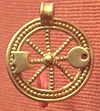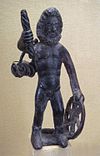Ocelus
| Mars Ocelus | |
|---|---|
| Other names | Mars Lenus, Ocelus Vellaunus |
| Major cult center | Venta Silurum,[1] Luguvalium Carvetiorum[2] |
| Animals | Bird (goose)[1][3] |
| Gender | Male |
| Equivalents | |
| Roman | Mars |
| Gaulish | Lenus[1][3] |
Ocelus is a Celtic god known from three inscriptions in Roman Britain. He is twice invoked on dedications at Caerwent: one stone is the base of a statue of which only a pair of human feet and a pair of goose feet survive. The invocation is to Mars Lenus or Ocelus Vellaunus and to the numen (divine spirit) of the emperor,[1][3] and was dedicated on 23 August AD 152. The second Caerwent inscription dedicates an altar to Mars Ocelus.[4] The god was also venerated at Carlisle, where he was once more equated with Mars and again linked to the imperial cult.[2] So Ocelus seems to have been a British, perhaps Silurian god, associated with Mars, probably in the latter's Celtic capacity as a protector. At Caerwent he is linked with Lenus, a Treveran healing deity, and with Vellaunus, who is also recorded among the Gaulish Allobroges;[5] the name "Vellaunus" has been glossed as 'chief' or 'commander'.[6]
One of the Caerwent inscriptions reads as follows:[4]
DEO / MARTI / OCELO / AEL(ius) AGVS/TINVS OP(tio) / V S L M
To the god Mars Ocelus, Aelius Agustinus, lieutenant, willingly and deservedly fulfilled his vow
(VSLM stands for uotum soluit libens merito, a familiar votive formula; an optio was an officer subordinate to a centurion.)
References
[edit]- ^ a b c d RIB 309
- ^ a b RIB 949
- ^ a b c d'Este, Sorita; Rankine, David (2007). The Isles of the Many Gods: An A-Z of the Pagan Gods & Goddesses of Ancient Britain worshipped during the First Millennium through to the Middle Ages. Avalonia. p. 173.
- ^ a b RIB 310
- ^ Green, Miranda (1997). Dictionary of Celtic Myth and Legend. London: Thames and Hudson Ltd.
- ^ Delamarre, Xavier (2003). Dictionnaire de la langue gauloise. Errance. p. 310.


